NEGenWeb Project
Church/Catholic
Franciscans
![]()
![]()
![]() COLUMBUS
COLUMBUS![]()
![]()
![]()
Chapter V
A NEW CITY IS DREAMED OF
In the spring of 1856 a group of twelve men met in Omaha with the express purpose of founding a new city. Most of these men were old-time friends and together had left their homes in Columbus, Ohio, a short time before. After some deliberation, The Columbus Town Company was organized and Vincent Kummer was made President. All twelve men became stockholders in the new venture.
Poring over some government maps of geographical locations as they were known then, the twelve decided to locate in a favorable section along the Loup River, on the north side, near the river's entrance into the Platte.
The reasons they had for selecting this territory were several. The Oregon Trail, old famous highway to the Golden West, ran along the north bank of the Platte for many miles, and the immigrants were accustomed to ford the Loup somewhere at that point, so that they could follow the Platte into Wyoming, or Colorado, if they chose The Denver Trail. A ferry at this point, they thought, would be a good business venture. Lying in the valley of a great river, they presumed that the land hereabouts would be as fine as could be found anywhere on the Plains and would afford them a decent livelihood. Then, too, there was, for many years past, agitation in Congress for the financing of a transcontinental railroad across the Plains, and, if the Bill went through, the twelve men thought it would probably be built along the general route of the Oregon Trail.
THE COMPANY SENDS OUT SCOUTS
On the strength of this reasoning, The Columbus Town Company sent out five of its members, Jacob Louis, Michael Schmid, Adam Denk, Frederick Gottschalk and George Rausch,* to act as scouts in the new country and to select sites for the new settlement. Hearing that there already was a settlement some miles northwest of a creek flowing into the Platte River about eighty miles west of Omaha, the five adventurers hunted the place up first, arriving there in May, 1856. They soon pushed on farther west, and touched the Loup about five miles above
*Both I. N. Taylor and the Author of "Platte County Past and Present," speak of only three explorers. According to Mr. F. Gottschalk and Mr. Jacob Louis there were five, as above.
the Junction. Here the scouts decided that the most advantageous place had been found, and with this belief, they returned to Omaha to report their findings.
COLUMBUS IS FOUNDED
The members of The Columbus Town Company, consisting mostly of Hessians and Suabians, at once marshalled (sic) their forces and in the same month of May, the twelve set out on their way to the site. They were organized as follows: Vincent Kummer, a Swiss, Captain; Charles Turner, Surveyor; John C. Wolfel, Carpenter; Frederick Gottschalk, Jacob Louis and George Rausch, Scouts; and Jacob Guter, Carl Reinke, Henry Lusche, Michael Schmid, Adam Denk and John Held.
The party of twelve, travelling (sic) by ox-team, arrived in the late afternoon and camped for the night on the north side of the Loup, near Buck Island. Taylor, in his History, does not say what day this was, and Mr. Jacob Louis, the last surviving member of the founders of Columbus, who left valuable information concerning the details of the settling of Columbus, was not able to recall how many days this was before the town of Columbus was actually settled.
Mr. Louis did recall, however, that there was a vast foliage along the two rivers, but to the north there was not a single tree as far as the eye could see. All was prairie grass and sky, and, in the distance, the north bluffs, marking the end of the river valley. It was, indeed, a dreary sight to glance over the great expanse of uninhabited plains. It seemed as though the twelve men had suddenly been transferred to a new planet where there lived no people and all was silence, save the chirping of a few tiny birds. Explorations up and down the two rivers went on for several days, it seems, and finally, on a clear, calm day, with no threatening weather, the twelve men drove their stakes on the present site of the county metropolis, and straightway christened the new town "Columbus". It was probably May 28, 1853.
THE FIRST BUILDING GOES UP
The first thing the men did was to erect a dwelling, wherein to lay their heads and to store most of their earthly possessions. Under the direction of J. C. Wolfel and his assistant, Carl
52
![]()
Reinke, trees were chopped down and hewed into shape. The log house was raised and, being in a hurry to get under cover, they placed thereon a grass roof. The house was built on the brewery block, and was known as "The Old Company House." It was later on sold for $20 and used as fuel and reinforcements.
THE FIRST WEEKS HERE
The first weeks spent here were monotonous ones for all. Most of the men possessed ox-teams, and they broke up little patches of ground and put in crops. Not much was realized from their labors. The grasshoppers ate up most of the plants, and when winter came upon them, starvation stalked also.
Their crop gone, the men in the little settlement went hunting every day, and brought home a great abundance of fresh meat, buffalo, elk, deer and many small prairie rodents.
THE GREAT SNOW OF 1856-1857
The Pawnee mind could not remember, nor the memory of the white recall, any time since then, when the winter was so severe and the snow so heavy as that first winter spent on the Plains. Columbus soon grew. On October 7, 1856, came the second group of people, consisting of John Rickly, J. P. Becker, John Browner, Anthony Voll, Charles Bremer, John Green, William Distlehorst, Jedediah Mills, George Berney, Martin Heintz, the Quinns, the Haneys and the first woman to settle here permanently, Mrs. J. C. Wolfel. And so, when the memorable year of 1856 rolled by, there were twenty-five souls in Platte County to face the ravages of the coming winter.
We have to rely a great deal on tradition concerning the romantic side of the first years spent in Columbus. Being handed down from person to person, this tradition is apt to become exaggerated and woven into legend, and so we kindly ask the reader to bear this in mind when these lines about the first snow are being read.
The entire Plains were early covered with a blanket of snow. Storm after storm left from three to ten feet of snow for miles around. Drifts rose to an enormous height. It was impossible to venture far away from the settlement for fear of being caught in a fresh storm that often came up out of a clear sky in a couple of hours.
THE SITUATION AT COLUMBUS
The only people then living in Platte county was the little band of pioneers at Columbus. These were huddled together in a few wretched huts rapidly put together a few months before. There was no saw mill here, and the dwellings, far too wretched to be called houses, were combinations of sod and rough logs hewed down by sheer human strength, with ax and hand saw. Grass comprised the greater part of the roofs.
The winter came sooner than the people from the East had expected, and in the early part of December, 1856, they suddenly found themselves practically without food and almost entirely snowbound. The weather was bitterly cold and the situation rapidly became very acute.
The destitute people held a council and decided that the only way out was to make a trip to Fort Calhoun or Omaha for supplies.
AID IS SECURED
Neither Taylor in his history, nor the accounts of pioneers given at Old Settlers' meetings of years ago, tell much about that trip for supplies. A few volunteers, their names forgotten, offered to go, but we do not know whether they travelled (sic) by horseback or ox-team. We do know, however, that they procured a few ox-teams in Omaha and after fixing up a small train of supplies, set out on the return trip via the Elkhorn River. The route proved false, and the snow soon became too deep to travel with wagons. A council was held. Only one way was open for them. Fitting up a series of hand sleds and loading them to capacity, these brave men set out afoot, provided with snow-shoes, across the frozen snows, dragging their sleds behind them, and in spite of the bitter cold, the men managed somehow to find their way back to the settlement.
A RECORD TRIP IS MADE
Not many days afterwards, it was found that a second trip was necessary. This time three colonists, J. Wolfel, C. Bremer and Haschberger Sr. and son followed the frozen bed of the Platte River as the quickest means of travel. These three men, legend says, made a record trip of ten days to Omaha and back, dragging a hand sled both ways. Thus writes I. N. Taylor in his chronicle.
COLUMBUS HAS COMPETITION
Shortly after Columbus was settled, the town was blocked out and the land divided among the members of the Corporation.
Only a few weeks afterwards an entirely different aggregation, imposingly known as The Elkhorn and Loup Fork Bridge and Ferry Company, managed by Messrs. Burtch and Mitchell, pulled in a few miles west of the claim of the twelve men and threatened to erect a ferry on a site which they called "Pawnee City".
Vincent Kummer lost no time in throwing out the olive branch, for he realized that Pawnee
53
![]()
City might develop into a real competitor. The Columbus Town Company was then reorganized and by taking in the rivals, the downfall of Pawnee City was made possible.
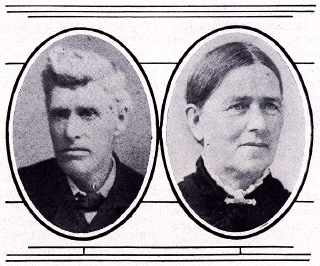
Mr. and Mrs. Thomas Lynch, Platte Center.
Colonel William Millar, a civil engineer and surveyor from Omaha, was hired to lay out the new plat. John Rickly and Vincent Kummer supervised the work. The streets and alleys were donated to the future citizens of Columbus. Each member, old and new, received a portion of the land. Certain blocks were also set aside to be donated to future manufacturers. For a testimonial, the Columbus Town Company later gave to Mrs. J. C. Wolfel one share of the capital stock of the Company, equal to ten average lots in the town, in recognition of her true pioneering spirit in being the first woman to locate in Columbus.
EARLY RELIGIOUS SERVICES
THE CATHOLICS ERECT A LOG CHURCH ABOUT 1860.
The Catholics were the first to organize a parish at Columbus. In 1860 John Browner and others erected a little lodge church on or about Eighth street and 18th Avenue, at the present John Staub, Sr., place. Since 1860 Rev. Almire Fourmont was the first resident priest.
Mrs. Patrick Gleason. |
Mrs. J. Gleason Fuller. |
Of the Protestant faiths first to be represented in Columbus, mention should be made of Rev. Jacob Adrianne, a Methodist minister, who is said to have preached the first religious sermon in Columbus on Sunday, May 16, 1858, in the dining room of the old American Hotel. The building was then located on the northwest corner of 7th Street and 21st Avenue. The hotel was later moved arid called The Grand Pacific. On June 25, 1867, a quarterly conference was held and organization of a church mission effected; services being held in the schoolhouse then located at 8th Street and 19th Avenue.
Methodist services were held in 1870 in the Congregational Church alternately in the evenings when Rev. Olmstead was then the min-
54
![]()
ister. On Feb. 10, 1871, a building Committee was appointed by the Methodists to build a church. Much parleying finally resulted in the Methodists and Presbyterians building a church together in 1871 on 27th Avenue, just north of the old John Compton residence. This church was auctioned off to the Methodists Nov. 20, 1875, and in 1873 the church was given the name of the First M. E. Church.
EPISCOPAL HISTORY
The first Episcopal service in Columbus was held by Rev. Samuel Goodale in June, 1866, in the old Court House. At the same time the parish of the Grace Church was organized. So successful was the parish that on December 19, 1869, a church was consecrated. The first services in the new church was the funeral of Judge Charles Whaley on December 19, 1869. A new church was built and consecrated in 1893 by Bishop Worthington at the present site, 14th Street and 25th Avenue. By 1875 there were seven congregations with church buildings in Columbus: Catholic, Episcopal, Congregational, Presbyterian, Methodist, Latter Day Saints, and German Reformed.
THE FIRST SUNDAY SCHOOL
The first Protestant Sunday School was organized in the spring of 1865, with I. N. Taylor, superintendent; George W. Stevens, secretary and librarian; H. J. Hudson, C. A. Speice, Michael Weaver and Johannah Bauer, teachers. It was held in the town hall, in the same room used by the Public school during the day. This hall was later bought by the Latter Day Saints and used for many years as that church's place of worship.
The Sunday School grew large and unwieldy. A library had been added which cost $80.00 and practically all the Protestant children, as well as their parents, attended its instructions.
THE FIRST PROTESTANT CHURCH BUILDING
The fact that the Sunday School outgrew its capacity was the real reason why the first Protestant church building was put up. The need of a church was felt, and the Congregational Church Society was formed from among the members of the Sunday School, September 2, 1865, for the purpose of erecting a church edifice, primarily to hold the Sunday School. The original membership of the Congregational Church was six.
Popular subscription made it possible to build a plain structure, 24x36 feet, costing a little over $1,000.00. For many years the membership of that first Sunday School was close to seventy. Five teachers were necessary to conduct its classes.
THE STORY OF THE PUBLIC SCHOOL
The first public school meeting held in Columbus took place in the American Hotel, March 1, 1860. At that time John Rickly, Michael Weaver and George W. Stevens were elected to the town's first school board. I. N. Taylor tells us about this first board meeting in the following quaint words: "On the 10th (of March) these three drew lots for the short, middle and long term of office, and took the oath of office, the jurat of which is in these words: 'Sworn to and subscribed in the presence of each other,' showing how scrupulously conscientious men were in those days. When they could swear to no greater, they swore to each other."
The first school census of Columbus was ordered by these three gentlemen, and it was completed in October, 1860, showing 46 boys and 20 girls of school age. 35 of these children lived east of the Meridian and 31 west of it.
It was decided by Messrs. Rickly, Weaver and Stevens to open a village school, but they had no building nor money with which to even rent one. Accordingly, on December 10, 1860, the town council donated the "Old Company House", the first building erected in Columbus, to the newly-created school board.
THE FIRST TEACHER
George W. Stevens, one of the members of the first school board, was chosen as the first teacher of Columbus. His school opened in December, 1860, with the children of the families of Rickly, Weaver, Wolfel, Ernst, Barnum, Hayes, and a few others. The "Old Company House", given by the town council to the school board, was used as the first school house. It stood on the block now partially occupied by the Columbus Beverage Company.
School sessions were brief in the old building, however, for the board moved the school into the newly-erected town hall in the spring of 1861. The "Old Company House" was thereupon sold to C. A. Speice on March 23, 1861, for $20.25. Mr. Speice tore the building down and converted it into firewood.
THE PROGRESS OF THE SCHOOL SYSTEM
The school system has grown wonderfully since the year 1860. In 1914 the number of pupils in Columbus schools was 1,215, while at the close of the 1928-1929 term the number was 1,405. There were, in June, 1929, 979 pupils in the Columbus grade schools and 412 in the city senior high school.
Property valuation of all public school buildings in the city in 1924 was $138,000.00, and in 1929 the figure was $650,000.00. Valuation of
55
![]()
equipment in buildings, 1914, $12,000.00; 1929, $44,000.00. Salaries paid to grade and high school instructors, 1914, $23,000.00; 1929, $71,845.51.
There are at present seven school buildings used by the Columbus public school system. 31 instructors are employed in the grade schools and 18 in the high school. Prof. R. R. McGee is the principal of the Kramer high school.
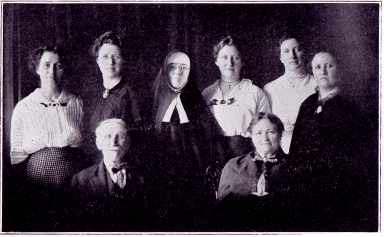
The Cronin Family, Platte Center.
A FERRY BOAT'S PRICES
In January, 1860, Leander Gerrard and Company was granted license to operate a ferry across the Loup River at Columbus, providing the following scale of prices was maintained:
| 2 horses, or oxen, and wagon |
$1.00 |
| 1 horse and wagon |
.75 |
| 1 extra team of horses, or oxen |
.25 |
| 1 horse and rider |
.25 |
| Live stock (per head) |
.10 |
| Footman (each) |
.05 |
WHAT THE COUNTY BOARD DID
An amusing passage is found in the minutes of a county board meeting held in 1861. A certain gentleman, George Sard, from out Genoa way, brought in a bill for election services in that precinct. The bill was probably for some other person from Monroe, as Sard, a peculiar fellow originally from Chicago, was known to have been a clerk at the Indian Reservation of Genoa.
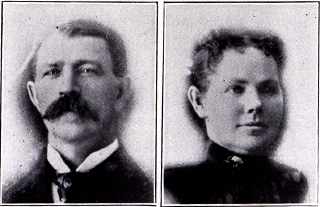
Mr. and Mrs. T. Donoghue, Platte Center.
The bill was no doubt legitimate enough, but the County Commissioners rejected the bill and advised Mr. Sard that the reason for so doing was that the Board did not favor having the people of Monroe precinct vote at every election, inasmuch as they lived in the Indian Rservation (sic) (or very near it, as was more the case), and if they were too cheap to live among white folks, they did not have much right to vote with white folks either.
The real reason probably was the wish of the County Commissioners, then predominatingly
56
![]()
Columbus-inclined, to discourage voting in Monroe for fear that Monroe might put over something to its own advantage. There was a great deal of strife between the two towns in the early days, when both had about the same population.
THE TOWN MOVES NORTH
IT IS INCORPORATED
Although settled nine years before, Columbus was not officially incorporated until 1865. The claims and legal papers were filed both in Dodge and Douglas counties. The original survey contained eighty acres.
Seventh Street was the principal business street of the city for many years, but there had always been objection to it on account of the nearness to the river, and so the drift northward was commenced. The Union Pacific, in laying its rails considerably north of the town of that day, also caused the buildings to move towards it.
By 1872, Seventh Street was entirely devoid of business houses, and by 1890, Eleventh Street was in its glory. Today Eleventh Street is outranked by Thirteenth Street, although both are still the principal business streets of the city.
The first licenses granted to sell liquor and operate saloons in Columbus were given April 22, 1861, to five different men.
A COMPARISON OF TWO FINANCIAL REPORTS
One of the most striking expressions of progress is the comparison of two financial reports of Platte County, twenty-five years apart. They were submitted in 1859 and 1884 respectively.
The following was drawn up for the July, 1859, session of the Board of County Commissioners, and gives the condition of affairs at the close of the fiscal year, July 1, 1859:
|
County Books |
$ 42.50 |
|
Freight on same |
3.50 |
|
Fees of county commissioners |
12.00 |
|
Salary of road supervisor |
10.00 |
|
Salary of county treasurer |
50.00 |
|
Election expense and fees of county clerk |
127.00 |
|
Total expenses for year |
$245.00 |
|
Income during year |
None |
Total amount of indebtedness of county up to date, July 1, 1861, $831.00.
The second financial report is a budget arranged by the Ways and Means Committee of the first Board of County Supervisors, when that body took over the government of Platte County in 1884. They asked for a list of likely expenses for the coming year, and this is what they received:
| For ordinary county revenue, including support of poor | $20,000 |
| County bridge fund | 5,000 |
| Funding fund | 12,000 |
| General bridge fund | 8,000 |
| Payment of interest on $100,000 L. and N. W. R. R. bonds | 10,000 |
| County bond sinking fund | 6,000 |
| Interest and 5% of principal on $15,000 of Butler Precinct bridge bonds | 3,000 |
| Payment of interest on $25,000 Columbus precinct railroad bonds | 2,000 |
| Estimated expenses for coming fiscal year | $66,000 |
COLUMBUS-AN EARLY OUTFITTING POST
From 1860 to 1885 Columbus was, as it has never been since, a real point of contact with the outside world. Situated on the great transcontinental railroad, the Union Pacific, with ample rail connections to the north and south, the city was a vantage point of supply to a large portion of Mid-Nebraska. Columbus was, in those days, a very busy trading center and outfitting post. People going to the fertile lands to the north and northwest replenished their stores here. Cowboys tending herds on the open ranges then common about these sections, drove their cattle to Columbus to be shipped to the Chicago market. Columbus had the air and bustle of a western cattle town. Liquor flowed abundantly.
THE EARLY SALOONS
From the time the first licenses to sell liquor were granted in 1861, to as late as 1875, the saloons kept open on the Sabbath day. It is said that Columbus was one of the very last places in the State to finally close its saloons on Sunday.
The "liquor trust" was strong in those days, and many advantageous ordinances were passed by the saloon crowd. It was not until almost 1900 that this "trust" was finally put out of commission.
The "Free-for-all Lunch Counter" was a favorite at all saloons. A wide variety of cheeses, meats, fish, breads and crackers were provided and served every noon from nine till twelve to anyone who bought a nickle schooner of beer. The patrons usually ate more food than the nickle beer would pay for, but the saloonkeepers figured that the customers would keep on buying nickle beers while eating the lunch. That was indeed usually the case.
The practise (sic) of free lunches was discontinued about the beginning of the twentieth century
57
![]()
by common consent of the saloon keepers. It was claimed by them that the price of food was mounting, loafers abused the practise (sic) and saloon taxes were becoming higher and higher.
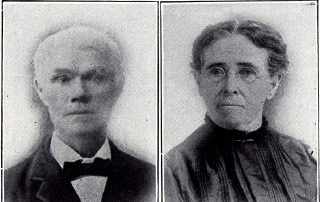
Mr. and Mrs. Dennis Regan, Platte Center.
THE FIRST COMMERCIAL CLUB IN COLUMBUS
The period of rapid growth in Columbus, just mentioned, was likewise the age of romance. Practically all of the old institutions now dear to the hearts of the citizens of the County's metropolis, were commenced in one or another of the years before 1885. Probably the first civic or commercial club to organize in Columbus was The Black Hills Mining Club in 1874. This club extolled the advantages of Columbus as a starting point for the rich gold fields just discovered in the Black Hills by a group of men under the auspices of the United States government. One member of this group of discoverers was Captain Lute North, a familiar figure about Columbus.
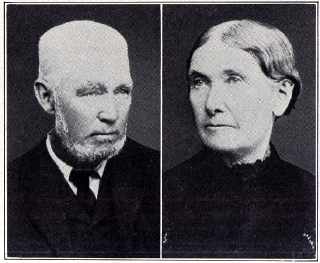
Mr. and Mrs. Pat Murphy, Platte Center.
The Black Hills Mining Club put out much advertising; proved again and again the natural selection of Columbus as a starting point to make up wagon trains, and it retained several old miners to convince the shaky that "ther's gold in dem hills." Scouts were hired to conduct trains from Columbus along the routes proposed by the club. The trail usually used, and advertised by the Club followed the Loup Valley for two hundred miles, then switched to the Niobrara and Cheyenne Rivers, together with several small streams. The route was so laid out, the Club boasted, that a prairie schooner could make the entire trip to the Black Hills and renew its water supply every day. The Black Hills Mining Club was a considerable success for a time, probably because its Secretary was none other than the energetic I. N. Taylor, Platte County's pioneer historian. At that time Taylor was a real estate agent, and the Club most likely brought him a wider acquaintance.
58
![]()
THE CITY'S SOCIAL LIFE EXPANDS
The Columbus Maennerchor Society, for over fifty years a leader in Columbus social circles, and dear to the hearts of thousands of our citizens, was organized March 1, 1877. Countless were the events held by the society in years gone by. The affairs of the Columbus Maennerchor Society were finally terminated in 1928, at the time the building erected by the society several years before was sold to the newly-formed Trinity Lutheran Church.
The first annual ball of the Columbus Engine Company Number One was held in 1872 and laid the foundation for an unbroken line of social activities sponsored by different units of the volunteer Columbus Fire Department.
THE COLUMBUS PUBLIC LIBRARY
The State Law permitting the erection of free, city libraries was passed in 1877. Agitation was soon started in Columbus for such a library. Accordingly, the Columbus Library Association was formed and incorporated under the Nebraska law with William Burgess, President, and E. L. Sherman, Secretary. It was not long before the free library itself made its appearance.
The present Columbus Public Library building was made possible through the generosity of the great philanthropist, Andrew Carnegie. The Carnegie Library Corporation, in October, 1913, offered the city $13,000 to build the structure according to plans approved by the corporation. The land on which the building now stands, on Fifteenth Street and Twenty-fifth Avenue, was donated at that time by the late Mrs. Betty Gerrard, widow of the well-known early day figure in Columbus, Leander Gerrard.
THE BANKS OF COLUMBUS
Of the banking institutions still in existence in Columbus, we find that The Columbus State Bank is the oldest. It was the outgrowth of the private banks of Gerrard and Reed and of Turner and Huest. These four gentlemen merged their businesses, moved into a spacious building, and opened their doors to the public, August 1, 1875. The Columbus State Bank took pride in being the second to be organized under the State Banking Law of Nebraska. This bank closed its doors in 1931.
The First National Bank, organized in 1882 and The Commercial National Bank of 1888 were also results of private interests enlarging. The Central National Bank was organized as The German National Bank in 1906. It absorbed The First National Bank in 1930. The Farmers State Bank entered the field in 1917.
Columbus, up to 1931, had never had a bank failure, a fact that is a tribute to the high standard of the bankers in the city themselves and to the continual normal conditions of agriculture in Platte County, especially in the territory served entirely by Columbus.
A STORY OF BUFFALO BILL
It has long been a legend of Columbus that the World Famous Wild West Show of Buffalo Bill was started here.
After Buffalo Bill--William F. Cody--who had been a soldier for Uncle Sam, and had gained much renown as a hunter of buffalo which he supplied to the working gangs of the new Union Pacific construction camps, he conceived the idea of appearing on the stage, showing the public some of the tricks he had learned while on the Plains. In company with Charlie and Ed Burgess, two Columbus men, Buffalo Bill toured the country, appearing to a great many people. The act was a huge success and great possibilities were seen.
At that time Buffalo Bill made his home near North Platte, Nebraska. In 1881 the city of North Platte planned a Fourth of July celebration and someone suggested that, inasmuch as the entertainer was home for a vacation, he might arrange a home talent show for the edification of the visitors.
Buffalo Bill consented to oblige his townspeople and rigged up a true-to-life drama of a stage coach being attacked by a party of Indians. An old stage coach that had actually been held up was luckily available. The show was a grand success and Buffalo Bill, at the urging of a great many friends, determined to go into the circus business.
Gathering several of the West's famous Indian fighters and plainsmen, such as Major Frank North, head of the renowned Pawnee Scouts, George Clother, Fred Mathews and later George W. Turner, all of Platte County, he commenced to assemble his band of Westerners. Many of the Pawnee Scouts themselves joined the troupe with their chief.
This unique aggregation of plainsmen, Indians, and people from many walks in life met in the spring of 1883 on the old fair grounds northwest of Columbus for rehearsals. Captain Lute North recalls that he was also invited to join the circus and was assigned to shooting glass balls. He practised (sic) on the fair grounds for about two weeks, but gave up his job because he was obliged to buy his own glass balls and by so doing was rapidly making himself penniless.
So promising were the try-outs that the first public performance of "Buffalo Bill's Wild West Show", for which admission was charged, was given in Omaha in May of 1881. The show met with instant approval. The largest cities
59
![]()
in the Union were eventually visited. Canada came next, and soon "Buffalo Bill's Wild West Show" became the greatest circus of its kind on the face of the earth. Then followed a series of European conquests, during which it played before many of the crowned heads of the Old World.
The show flourished for a number of years, but Cody sold his equipment to a circus organization in 1912 or 1913, while in Denver as a result of financial difficulties, and later was employed for a time as a circus performer.
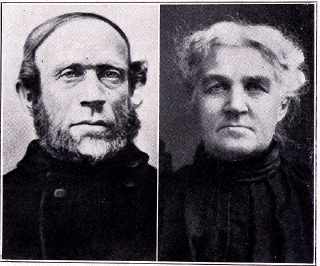
Mr. and Mrs. Edmond Roberts, Platte Center.
THE PEOPLE OF COLUMBUS GET A REAL SCARE
Probably the only real scare received in Columbus, save the earlier Indian rumors and depredations, was an earthquake felt on November 15, 1877. The tremor commenced at 11:35, at noon, and lasted half a minute, there being two distinct waves. The shock affected all of the two-story buildings in Columbus. District Number one school house, a brick building, had its walls cracked in two places. School was dismissed for the day. The people on the second floor of the Columbus State Bank building could hear mortar crack and feel the walls move.
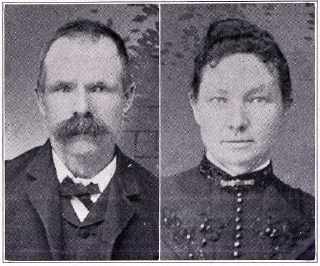
Mr. and Mrs. John Hennessy, Platte Center.
The attendance at District Number One school dropped down to practically nothing, a rumor going around that the little tots were in danger in the building. The condition became so serious that Judge J. G. Higgins, a member of the School Board, held a mass meeting, at which he was able to convince the people that the facts were greatly exaggerated, and that the building was really safe. By his eloquence he was able to induce the parents to send their children to the school again.
60
![]()
FORTY YEARS AGO
Forty years ago Columbus had all the modern conveniences of the day, such as water works, electric lights, telephone system, street cars, and three wide-awake newspapers--one of them a daily. It boasted of well-conducted stores of all descriptions, coal and lumber yards, elevators, and many home industries, among which there was a windmill factory, creamery, wooden shoe factory, brewery, pop factory, two cigar factories, a nursery, broom factory, marble works, and two of the largest flour mills in the state.
Many farmers were raising sugar beets for a factory in Grand Island, realizing $25.00 per acre clear. One man with a team of horses would tend 20 acres.
While the farmer-members of The Platte Farmers' Club were seriously discussing the advantages of the new disc-harrow, the women held secret meets of their own each week, and supposedly talked on the proper manner of washing overalls.
Those were also the days when the city band used to turn out en masse to serenade a newly-married couple. They would perpetrate their meanness in the town square. The Oconee concert band also used to slip into Columbus and give a concert when it was certain that the Columbus boys would not be able to get together. Newspapers attacked each other with vim and viciousness. Everyone believed in free speech, and if the parties did not like what a paper printed, there was either a fist fight or the subscription stopped--sometimes both.
A LITTLE STORY
An interesting insight into the manner in which county treasurers here years ago turned over the funds in their custody to their successors in office was published in The Weekly Telegram of January 11, 1900. It was the occasion of quite a ceremony, and was written up as follows:
"On Monday last, Ex-Treasurer Elliott turned over to his successor in office, Treasurer John G. Becher, the sum of $49,734.02 in full settlement with Platte County. Every dollar of this sum was turned over in cash, and consumed nearly two and one-half hours in counting. The settlement was made in the presence of Supervisors Held and Carrig and several other gentlemen who happened to be in the treasurer's office at the time the transfer was being made.
Early Monday morning Treasurer Elliott telephoned for a carriage to meet him at the court house, and at ten o'clock he was immediately conveyed to the First National Bank where a portion of the county funds were on deposit.
The greater part of this amount was in gold, and it was emptied into a strong grain sack. From the First National he was driven to the Commercial Bank where more funds were collected, and from there to the State Bank where the remainder of the county funds were on deposit. When all was collected the ex-treasurer found that he had in his possession a sack full of cash, besides a large grip and a box, which was overflowing. Arriving at the treasurer's office the work of counting this money commenced and after the transfer of funds was made and accounted for, the money was again conveyed back to the banks for safekeeping."
BACK IN 1890
Back in 1890 things were running along at a merry pace in Columbus. Social affairs were at their height. There was always plenty of noise. Fullerton at that time had a ladies' cornet band, and it seems that the boys in the Columbus band called often on their fair friends to help them out on community celebrations.
Parades usually started along Thirteenth Street somewhere and were in full swing when they reached Eleventh, the principal business street of that day. The Grand Pacific Hotel housed the city's chief guests. The merrymakers known as the Calithumpians usually donated a funny side.
The Fourth of July parade of that year, for instance, had floats from the following wide-awake merchants of that day. Some of them are still with us: Hugh Hughes, lumber; Friedhof and Company, dry goods; George Lehman, cigars; Grand Pacific Hotel; Emil Pohl, Henry Ragatz and Company and J. B. Delsman, all grocers; Sam Gass, furniture; A. Dussell, plumbing; Maurice A. Meyers, clothier; J. A. Barber, dry goods; S. C. and C. C. Gray, hardware; J. H. Galley, dry goods, and the Abts Saloon, the latter featuring, as the newspaper account of that day reads, "a display of original packages."
There were horse races between different units of the Columbus and Schuyler Fire Departments, in which the Bissells of this city nosed out a victory; foot races, greased pig races and wheelbarrow races. Fireworks were set off in lavish style, and a big banquet was served by the merchants of the city to the travelling (sic) men, making Columbus. Tom McTaggert, then manager of the street car lines in the city, had just finished straightening out the car tracks and did an immense business with his horse-drawn vehicles. Everyone appeared happy, worked hard and enjoyed himself in the height of fashion-it was "The Good Old Days" in full swing.
61
![]()
A UNIQUE MEMORIAL SERVICE
Probably the most colorful memorial service ever held in Columbus took place at the tomb of Major Frank North, famous commander of the Pawnee Scouts and member of Buffalo Bill's Show, on September 3, 1909.
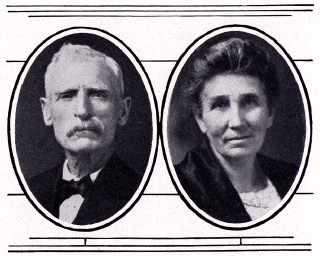
Mr. and Mrs. Henry Zingg, Platte Center.
The company of distinguished visitors was headed by Colonel W. F. (Buffalo Bill) Cody and Major Gordon W. (Pawnee Bill) Lille. These two internationally known showmen, then in the full glory of their circus success, came to Columbus in company with many of their performers who had known and loved the man who, in so many capacities, had made the Wild West Show as well as the country it represented, the pride that both were then.
The services, although read in direct honor of Major North, were also in memory of two other famous plainsmen who had, with Major North, made Nebraska history years before and had died previously. They were Captain Frank Matthews and George W. Clother, members of the original Wild West Show of thirty years before.
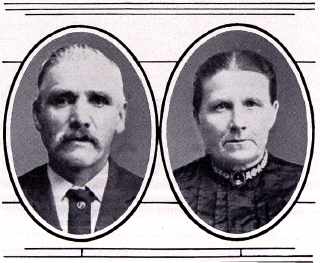
Mr. and Mrs. J. Purchal, Platte Center.
Members of the Wild West Show and the Far East companies lent picturesqueness to the occasion by appearing in costumes emblematic of their native environments. There were cowboys from the Western Plains, Indians dressed in their tribal costumes, military men from all over the globe, and many Orientals garbed in their native finery. Men who had themselves been actually engaged in the task of empire-building, such as Captain Lute North, Lieutenant George Lehman and Captain Gus O.
62
![]()
Becher, were present to pay their respects to their dead brother and companion.
Dean Beecher, of the Trinity Cathedral of Omaha, conducted the services and Captain William Sweeney's Cowboy Band played "Nearer My God to Thee" and "Star Spangled Banner". While the national anthem was being played, Johnny Baker, foster son of "Buffalo Bill", and himself a man of international fame, unfurled the Stars arid Stripes at the head of Major North's grave. A squad of Zouaves fired the military salute and a cavalryman sounded "Taps" over the grave of the famous scout.
THE YOUNG MEN'S CHRISTIAN ASSOCIATION
There had been, for a long time, agitation for a Young Men's Christian Association building in Columbus and, as the result of patient labors, a group of subscribers met in the city council chamber April 23, 1907 and empowered a provisional committee of nine men to collect subscriptions, select a site for the building and let the construction contracts. C. C. Sheldon was chairman of the building committee. The architectural plans were drawn by Charles Wurdeman and the building contract let to John Parker. Both were citizens of this city, the latter having since gone to the other life.
So successful was the work of the committee that the first brick in the Y. M. C. A. building was laid October 2, 1907 by H. F. Hockenberger, one of the organization's most prominent members in that day, as he is today.
The cornerstone of the new building was laid with due ceremony November 22, 1907, by Hon. Orman J. King, grand master of the Masonic lodge in Nebraska. Hon. George L. Sheldon, Governor of Nebraska, headed the list of speakers. An impressive procession through the city's, streets was also held.
Celebrations incident to the opening of the Y. M. C. A. building to the community consumed one full week. It was announced then that total cost of the building and site was $34,437.46.
THE PROGRESS OF THE CITY
Columbus was made a city of the first class by a document signed by Governor George L. Sheldon and bearing the date of Friday, September 25, 1907. The proclamation itself was sent to Mayor G. W. Phillips and placed on record at the City Council Chamber files.
The Columbus Commercial Club was organized in November, 1906, by 12 leading merchants of the city. The first set of officers was: President, M. D. Karr; Secretary, F. H. Abbott; First Vice-president, C. C. Gray; Second Vice-president, L. G. Zinnecker; Third Vice-president, Tom Branigan; Treasurer, G. W. Phillips.
The Census of 1910 for Columbus was 5,014. In 1920 the figure was 5,410. The Columbus Telegram, in commenting on the disappointing report, had this to say in 1920:
"In 1910 the census was 5,014, but at that time Columbus was striving to become a city of the first class and it is said that not all the noses counted were worn by permanent residents of the community. On the face of the figures, the increase is only 396, or 7.9 per cent in 10 years."
It is confidently hoped that the census to be taken in 1930 will place Columbus well in the 7,000 class. The 1930 census gives Columbus 6,898 inhabitants.
A BOYS' CAMP IS BUILT
The State Young Men's Christian Association Boys' Camp was located at Columbus, February 3, 1919, by the Special Site Committee of the State Y. M. C. A. Mr. C. C. Sheldon, Columbus' own philanthropist, was a member of this Committee, and it was his vote that finally decided on Columbus. Members of the C. H. Sheldon family donated a 25-acre piece of ground on Barnum Creek. Popular subscription at the beginning amounted to $4,575, which amount was considerably increased as time went on.
The State Y. M. C. A. spent about $20,000 on the Camp originally, and many new things have been installed since that time. Camp Sheldon, the name of the new Boys' Camp, was dedicated June 14 and 15, 1919, amid appropriate ceremonies.
THE FIRST AUTOMOBILE ORDINANCE OF COLUMBUS
The first city ordinance regulating the maximum speed of automobiles was passed by the Columbus city council, June 4, 1909, and provided that the "buzz wagons" should not run at a greater speed than 10 miles per hour in the business sections and 15 miles in the residential districts.
The ordinance, thought to have been provoked by the tragic death of a Lincoln man from collision with a speeding auto, provided that all motor vehicles be equipped with suitable brakes, a horn or sounding device able to be heard at a reasonable distance, and display one or more white lights from one hour after sunset to one hour before sunrise when the machine was in use at night.
Every motor vehicle owner was obliged to receive a number from the secretary of state, which number was to be painted in conspicuous Arabic figures in the rear of the car, either on the machine itself or on a suitable board. Motor car drivers were also commanded by rule to
63
![]()
stop, when so requested by a signal from a driver or rider of a horse or other animal.
The penalty for disobeying these rules called for a fine of not less than $25 for the first offense, nor more than $50 for each subsequent offense.
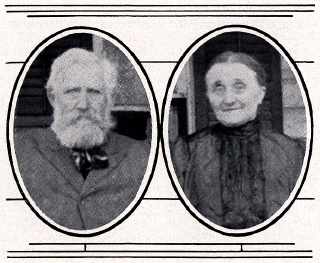
Mr. and Mrs. Stracke, Platte Center
THE CITY OF COLUMBUS TODAY
LOCATION
Columbus, Nebraska, 'The Cross-roads of America", is located on the junction of two great transcontinental highways--the Lincoln Highway, stretching from New York City to San Francisco, and the Meridian Highway, reaching from Winnipeg, Canada, to Galveston, Texas, and now being extended into Old Mexico.
Columbus is 87 miles, by rail, west of Omaha, and has outlets by rail in every direction, as well as ample highway facilities forming a net work of arteries for traffic throughout its broad trade territory. It is a steadily growing city of nearly 7,500 population and its building improvements the past four years or more have averaged well over $350,000 a year. This is exclusive of the paving, drainage, park and other civic improvements.
Mr. and Mrs. Max Bruckner, Platte Center |
Rev. Paul Bruckner, S. J. |
The trade territory which is primarily dependent upon Columbus for wholesale and retail shopping goods includes the major portion of 10 counties, the exclusive retail area covering a radius of about 25 miles, There is no other city of the size of Columbus within 50 miles in any direction.
HOTELS, OFFICES
The hotels of Columbus have 270 guest rooms, there are numerous boarding and rooming
64
![]()
houses with additional accommodations. There are 11 restaurants. The professional and miscellaneous businesses are well represented and include prominent physicians, surgeons, dentists, attorneys, engineers, architects, and substantial real estate, contracting and insurance firms. The City of Columbus and its retail trade territory are served by a daily newspaper, The Columbus Daily Telegram, with over 4,000 circulation.
The automobile business is apparently very good in Columbus, since there were 947 automobile licenses and 112 truck licenses issued to owners in Columbus in 1928. In Platte County the automobile licenses numbered about 5,900 and trucks, 600.
BUSINESS HOUSES
Columbus has approximately 167 retail business establishments. The list of wholesale and manufacturing firms numbers more than 25, among which are: Nash-Dietz Co., groceries; Ulry-Talbert Co., groceries; F. E. Teller, office supplies, paper, tobacco and candy; Reece Wooden Sole Shoe Co., wooden sole shoes; Acme Products Co., a wide variety of bottled pastes, creams and liquids manufactured by them; Columbus Brick Works, bricks; Columbus Milling Co., flour and feeds; Swift and Co., poultry and dairy products; T. B. Hord Grain Co., commercial feeds; Segelke Bottling Co., and Columbus Beverage Co., bottled soft drinks; Harding Cream Co., ice cream; Glur Cement Works, cement blocks; Columbus Planing Mill, mill work; Klaus and Moerson Canning Co., canned meats and vegetables; Columbus Hatcheries, chicks; Columbus Baking Co., Braun's, Stanzel's, Albert Gloor's, Jones' and Wittka's, bakeries.
SCHOOLS, PUBLIC AND PAROCHIAL
The Columbus school district maintains a full accredited 12-year course of study. The schools are organized on the modern basis of six years elementary, two years junior high and four years senior high. The senior high is departmentalized with full equipment of literary and athletic activities. The Columbus public school system has seven school buildings, including one high school, senior; one high school, junior; and five graded schools. The value of the public school property in Columbus is $649,000, with annual teachers' salaries amounting to $66,785. In the five graded schools and junior high school there is an enrollment of 936 pupils, making an average of 30 pupils to each instructor. The high school has an enrollment of 414 pupils, with 13 instructors.
Columbus has, in addition to its public schools, three parochial schools with total school property valued at about $96,000. There are also in the city 10 teachers of music, which includes voice, piano, violin, cello and other instruments. There is also the Cuscaden School of Music, a regularly-conducted musical school.
PUBLIC LIBRARY
The Columbus public library is a beautiful building and nicely equipped. The cost of the building and property is near $20,000, not including the site, which was donated. Between May, 1925, and May, 1926, there were 36,733 books circulated. In the same months in 1927 and 1928 there were 47,554 books circulated, showing an enormous increase in the number of readers. There are over 2,000 registered patrons, and over 10,000 volumes in the library. The daily number of readers using the library averages over 100.
CHURCHES AND THE Y. M. C. A.
There are 12 churches in Columbus, all maintaining splendid church homes. The Young Men's Christian Association is well equipped and generously supported. Near Columbus, with a beautiful location on Barnum Creek, is Camp Sheldon, the Y. M. C. A. camp for Nebraska boys. Hundreds of 'boys from all over the State attend this recreation spot in the summer time.
SOCIAL AND OTHER CLUBS
A leading social organization is The Wayside Country Club which maintains one of the finest golf courses in Nebraska. Some of the active fraternal and civic organizations in Columbus are the Elks, Rotarians, Lions, Masons, Knights of Columbus, Modern Woodmen, Knights of Pythias, Odd Fellows, Business and Professional Women's Club, B. P. O. Does, Eagles, Catholic Daughters of America, Chamber of Commerce. The local American Legion Post, Hartman Post, No. 84, is very active and through its 40 and 8 organization, has one of the finest drum and bugle corps in Nebraska.
HOSPITALS
The St. Mary's Hospital and the Columbus Hospital are both large institutions, receiving patients from a much larger territory than the trade territory of Columbus, which would further confirm the fact that the attending staffs of those hospitals are very expert.
THEATERS AND PARKS
Columbus maintains three good theatres, in which are shown the latest entertainment including stuck plays, moving pictures, vaudeville, vitaphone and movie-tone.
There are six parks in our city park system,
65
![]()
in and near town. The largest and newest is Pawnee Park, consisting of 82 acres located across the road from the Wayside County Club, north of the Loup River on the combined Lincoln Highway and Meridian Highway. This park is termed "The Picnic Grounds of Mid-Nebraska". There is found an old land mark, the Wolfel Krumei house, built in 1856 or 1857. This oldest house (originally a log house) was transferred to the Park in March, 1930. At the election held April 2, 1930, a $25,000 bond issue was voted on to install a modern swimming pool in Pawnee Park. It carried by a majority of a few votes.
Frankfort Square is located in the heart of the city, and consists of one square city block. It has beautiful flower beds, trees, and a Civil War memorial. The city band stand is also located in the Square, where weekly concerts are given by the Columbus City Band in the summer time. The total value of the city's parks is estimated at $158,850.
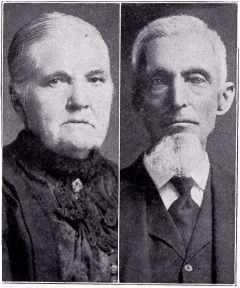
Mr. and Mrs. J. P. Bender, Humphrey, Neb.
John Ciochon |
Mrs. John Ciochon |
66
![]()
|
|||